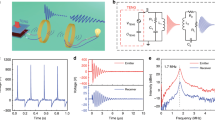Abstract
Inductive powering can free microelectromechanical systems (MEMS) devices from tethering to a power supply, thus expanding their scope of applications. We investigate inductive powering for MEMS using a microfabricated coil as a receiver operating at and below 1 MHz. The microcoil is designed to enclose the MEMS functions to achieve maximum coupling, and is built into a silicon substrate by our inlaid electroplating process, so that the microcoil has a small resistance despite its long trace. Non-negligible parasitic effects from the silicon substrate affect the characterization of an inductive link and its optimization. Taking into account the parasitic effects of Si microcoils, the coupling coefficient of the link is determined by a coil-model scheme that is different from conventional strategies. Furthermore, an equivalent circuit is developed for our link and used to analyze link operation over the frequency range of 4 kHz to 4 MHz. With measured link parameters, link efficiency is calculated with our equivalent circuit, and the results agree better with experiments than do conventional models. The equivalent circuit also indicates that microcoils with high quality factor at low frequencies, such as our inlaid electroplated coils, improve link performance, while parasitic capacitance has little effect.
Similar content being viewed by others
References
N. de N. Donaldson and T.A. Perkins, Med. & Biol. Eng. & Comput., 21, 612 (1983).
D.C. Galbraith, M. Soma, and R.L. White, IEEE Trans. Biomed.Eng., BME-34, 265 (1987).
N. de N. Donaldson, Med.&Biol. Eng. & Comput., 21, 756 (1983).
C.M. Zierhofer and E.S. Hochmair, IEEE Trans. Biomed. Eng., 37, 716 (1990).
G.B. Joung and B.H. Cho, IEEE Trans. Power Electron., 13, 1013 (1998).
K. Van Schuylenbergh, Optimisation of inductive powering of smallbiotelemetry implants, Ph.D. dissertation, Katholieke Universiteit Leuven, 1998.
H. Sakamoto, K. Harada, S. Washimiya, and K. Takehara, IEEETrans. Magn., 35 3526, (1999).
W.J. Heetderks, IEEE Trans. Biomed. Eng., 35, 323 (1988).
T.H. Nishimura, T. Eguchi, A. Kubota, M. Hatori, and M. Saito, Proc. 20th Annul Int'l Conf. IEEE Eng. in Medicine and Biol.Soc., 20, 432–435 (1998).
J. Zhao, C.F. Foo, and K.J. Tseng, IEEE Trans. Magn., 35, 3550 (1999).
D. Dudenbostel, K. Krieger, C. Candler, and R. Laur, TRANSDUCERS'97, Chicago, (1997), pp. 995–998.
J.A. Von Arx and K. Najafi, TRANSDUCERS'97, Chicago, pp.999–1002.
R. Puers, G. Vandevoorde, and D. De bruyker, J. Micromech.Microeng., 10, 124 (2000).
S. Takeuchi, N. Futai, and I. Shimoyama, MEMS 2001—14th IEEEInt'l Conf. MEMS, Interlaken, Switzerland, (2001), pp. 574–577.
A. De Hennis and K.D. Wise, MEMS 2002, Las Vegas, LV, (2002), pp. 252–255.
J.-B. Yoon, C.-H. Han, E. Yoon and C.-K. Kim, IEEE MTT-S Int.Microwave Symp. Dig., 1523–1526 (June 1999).
J.-B. Yoon, C.-H. Han, E. Yoon and C.-K. Kim, IEEE Int.Electron Devices Meet. Tech. Dig., 753–756 (1999).
J. Wu and G.H. Bernstein, “An inlaid electroplated copper coil foron-chip powering of MEMS devices,” J. Vac. Sci. Technol. B, 22, 611–618 (2004).
J. Wu, V. Quinn, and G.H. Bernstein, “Powering efficiency ofinductive links with inlaid electroplated microcoils,” J.Micromech. Microeng., 14, 576–586 (2004).
W. Bacher, W. Menz, and J. Moh, “The LIGA technique and itspotential for microsystems-a survey,” IEEE Trans. Industrial Electron., 42, 431–441 (1995).
Author information
Authors and Affiliations
Rights and permissions
About this article
Cite this article
Wu, J., Quinn, V. & Bernstein, G.H. An Inductive Link with Integrated Receiving Coil—Coupling Coefficient and Link Efficiency. J Comput Electron 4, 221–230 (2005). https://doi.org/10.1007/s10825-005-5038-z
Issue Date:
DOI: https://doi.org/10.1007/s10825-005-5038-z




